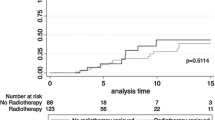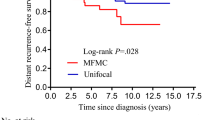Abstract
Background Data on distant disease-free interval (DDFI) and the localization of the first distant metastasis (DM) in BRCA1- and BRCA2-associated breast cancer (BC) patients are as yet scarcely available. Patients and methods We identified 57 BRCA1-associated and 31 BRCA2-associated BC patients, diagnosed between 1980 and 2001, and developing DM disease before 2004, July 1. DDFI, the site(s) of first DM and post-relapse survival of these patients were compared with those of 192 sporadic BC patients. Results As compared to sporadic patients, BRCA1 patients developed less often bone DM (30% vs. 51%; P = 0.005), but tended to develop more often lung DM (26% vs. 16%; P = 0.07), and DM at multiple sites (44% vs. 32%; P = 0.11). In BRCA2-associated compared to sporadic patients, first DM more commonly occurred in lymph nodes (23% vs. 7%; P = 0.007) and at multiple sites (48% vs. 32%; P = 0.08). Adjuvant systemic therapy appeared to be most effective in BRCA2 mutation carriers. Post-relapse survival was worse for BRCA1- and better for BRCA2-associated patients as compared to sporadic patients, but differences disappeared after adjustment for ER-status, site of first DM and DDFI. Conclusion The site of first DM is different between BRCA1- and BRCA2-associated and sporadic BC patients. Differences in post-relapse survival could be explained by differences in site of first DM, in ER-status and in DDFI. Treatment efficacy may differ dependent on genetic status.

Similar content being viewed by others
Abbreviations
- BC:
-
Breast cancer
- DDFI:
-
Distant disease-free interval
- DM:
-
Distant metastasis
- ER:
-
Estrogen receptor
- PgR:
-
Progesterone receptor
References
Lakhani SR, Jacquemier J, Sloane JP et al (1998) Multifactorial analysis of differences between sporadic breast cancers and cancers involving BRCA1 and BRCA2 mutations. J Natl Cancer Inst 90:1138–1145
Verhoog LC, Brekelmans CT, Seynaeve C et al (1998) Survival and tumour characteristics of breast-cancer patients with germline mutations of BRCA1. Lancet 351:316–321
Lakhani SR, van de Vijver MJ, Jacquemier J et al (2002) The pathology of familial breast cancer: predictive value of immunohistochemical markers estrogen receptor, progesterone receptor, HER-2, and p53 in patients with mutations in BRCA1 and BRCA2. J Clin Oncol 20:2310–2318
Palacios J, Honrado E, Osorio A et al (2003) Immunohistochemical characteristics defined by tissue microarray of hereditary breast cancer not attributable to BRCA1 or BRCA2 mutations: differences from breast carcinomas arising in BRCA1 and BRCA2 mutation carriers. Clin Cancer Res 9:3606–3614
Hamann U, Sinn HP (2000) Survival and tumor characteristics of German hereditary breast cancer patients. Breast Cancer Res Treat 59:185–192
Pierce LJ, Strawderman M, Narod SA et al (2000) Effect of radiotherapy after breast-conserving treatment in women with breast cancer and germline BRCA1/2 mutations. J Clin Oncol 18:3360–3369
Robson ME, Chappuis PO, Satagopan J et al (2004) A combined analysis of outcome following breast cancer: differences in survival based on BRCA1/BRCA2 mutation status and administration of adjuvant treatment. Breast Cancer Res 6:R8–R17
Rennert G, Bisland-Naggan S, Barnett-Griness O et al (2007) Clinical outcomes of breast cancer in carriers of BRCA1 and BRCA2 mutations. N Engl J Med 357:115–123
Brekelmans CT, Seynaeve C, Menke-Pluymers M et al (2006) Survival and prognostic factors in BRCA1-associated breast cancer. Ann Oncol 17:391–400
Liebens FP, Carly B, Pastijn A et al (2007) Management of BRCA1/2 associated breast cancer: a systematic qualitative review of the state of knowledge in 2006. Eur J Cancer 43:238–257
Breast Cancer Linkage Consortium (1997) Pathology of familial breast cancer: differences between breast cancers in carriers of BRCA1 or BRCA2 mutations and sporadic cases. Lancet 349:1505–1510
Brekelmans CT, Tilanus-Linthorst MM, Seynaeve C et al (2007) Tumour characteristics, survival and prognostic factors of hereditary breast cancer from BRCA2-, BRCA1-and non-BRCA1/2 families as compared to sporadic breast cancer cases. Eur J Cancer 43:867–876
Eerola H, Heikkila P, Tamminen A et al (2005) Histopathological features of breast tumours in BRCA1, BRCA2 and mutation-negative breast cancer families. Breast Cancer Res 7:R93–R100
Verhoog LC, Brekelmans CT, Seynaeve C et al (1999) Survival in hereditary breast cancer associated with germline mutations of BRCA2. J Clin Oncol 17:3396–3402
Loman N, Johannsson O, Bendahl P et al (2000) Prognosis and clinical presentation of BRCA2-associated breast cancer. Eur J Cancer 36:1365–1373
Clark GM, Sledge GW Jr, Osborne CK et al (1987) Survival from first recurrence: relative importance of prognostic factors in 1,015 breast cancer patients. J Clin Oncol 5:55–61
Alexieva-Figusch J, Van Putten WL, Blankenstein MA et al (1988) The prognostic value and relationships of patient characteristics, estrogen and progestin receptors, and site of relapse in primary breast cancer. Cancer 61:758–768
Solomayer EF, Diel IJ, Meyberg GC et al (2000) Metastatic breast cancer: clinical course, prognosis and therapy related to the first site of metastasis Breast Cancer Res Treat 59:271–278
Elder EE, Kennedy CW, Gluch L et al (2006) Patterns of breast cancer relapse. Eur J Surg Oncol 32:922–927
Tischkowitz MD, Foulkes WD (2006) The basal phenotype of BRCA1-related breast cancer: past, present and future. Cell Cycle 5:963–967
Albiges L, Andre F, Balleyguier C et al (2005) Spectrum of breast cancer metastasis in BRCA1 mutation carriers: highly increased incidence of brain metastases. Ann Oncol 16:1846–1847
van der Hout AH, van den Ouweland AM, van der Luijt RB et al (2006) A DGGE system for comprehensive mutation screening of BRCA1 and BRCA2: application in a Dutch cancer clinic setting. Hum Mutat 27:654–666
Slimane K, Andre F, Delaloge S et al (2004) Risk factors for brain relapse in patients with metastatic breast cancer. Ann Oncol 15:1640–1644
Minn AJ, Gupta GP, Siegel PM et al (2005) Genes that mediate breast cancer metastasis to lung. Nature 436:518–524
Chappuis PO, Goffin J, Wong N et al (2002) A significant response to neoadjuvant chemotherapy in BRCA1/2 related breast cancer. J Med Genet 39:608–610
Kennedy RD, Quinn JE, Mullan PB et al (2004) The role of BRCA1 in the cellular response to chemotherapy. J Natl Cancer Inst 96:1659–1668
Foulkes WD (2006) BRCA1 and BRCA2: chemosensitivity, treatment outcomes and prognosis. Fam Cancer 5:135–142
Powles T, McCroskey E, Paterson A (2006) Oral bisphosphonates as adjuvant therapy for operable breast cancer. Clin Cancer Res 12:6301s–6304s
Tutt AN, Lord CJ, McCabe N et al (2005) Exploiting the DNA repair defect in BRCA mutant cells in the design of new therapeutic strategies for cancer. Cold Spring Harb Symp Quant Biol 70:139–148
Lakhani SR, Reis-Filho JS, Fulford L et al (2005) Prediction of BRCA1 status in patients with breast cancer using estrogen receptor and basal phenotype. Clin Cancer Res 11:5175–5180
Acknowledgements
The study was supported by a grant from the Dutch Cancer Society (DDHK 2004-3124) and Cancer Genomics Center. We thank Ellen Crepin, Jannet Blom and Elisabeth Huijskens for the collection of data.
Author information
Authors and Affiliations
Corresponding author
Rights and permissions
About this article
Cite this article
Kriege, M., Seynaeve, C., Meijers-Heijboer, H. et al. Distant disease-free interval, site of first relapse and post-relapse survival in BRCA1- and BRCA2-associated compared to sporadic breast cancer patients. Breast Cancer Res Treat 111, 303–311 (2008). https://doi.org/10.1007/s10549-007-9781-7
Received:
Accepted:
Published:
Issue Date:
DOI: https://doi.org/10.1007/s10549-007-9781-7




